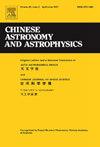Wulong: A New Main Group Pallasite
Q4 Physics and Astronomy
引用次数: 0
Abstract
As the fragments of differentiated asteroids in the early solar system, pallasites record deep-mantle and core processes. As such, studying the origin of pallasites could help us understand the formation and differentiation processes governing the evolution of planets. Wulong pallasite was found in Inner Mongolia, China around 1992, but didn't get much attention until 2020. In this study, we reported the detailed petrography and mineralogy, oxygen isotopic composition, and metal phase chemistry of Wulong pallasite. Wulong pallasite is mainly composed of olivine ( 72.7 vol.%), Fe-Ni metal ( 26.2 vol.%), troilite ( 0.6 vol.%), schreibersite ( 0.4 vol.%), and chromite ( 0.1 vol.%) etc. Olivine (Fa) and chromite (Al15.2 0.9, Fe 67.9 1.5) compositions are homogeneous, and no chemical zoning is observed. Siderophile element contents of a metal phase are Ni, 7.71 wt.%; Ga, 17.8 g/g; and Ge, 26.2 g/g. The mean O value is 3.04 0.01‰, O value is 0.18 0.01‰. In terms of the Fa value of olivine, metal phase chemistry, and oxygen isotope ratios, Wulong could be a new member of main group pallasite.
武隆:一个新的主群Pallasite
作为太阳系早期分化小行星的碎片,pallasites记录了深部地幔和岩心过程。因此,研究pallasites的起源可以帮助我们理解控制行星演化的形成和分化过程。武隆pallasite是1992年左右在中国内蒙古发现的,但直到2020年才引起人们的关注。本文详细报道了武隆pallasite的岩相学、矿物学、氧同位素组成和金属相化学。武隆pallasite主要由橄榄石(~ 72.7 vol.%)、Fe-Ni金属(~ 26.2 vol.%)、三硅石(~ 0.6 vol.%)、schreiberite (~ 0.4 vol.%)、铬铁矿(~ 0.1 vol.%)等组成。橄榄石(Fa12.5±0.2)和铬铁矿(Al# ~ 15.2±0.9,Fe# ~ 67.9±1.5)组成均匀,无化学分带。金属相的亲铁元素含量为Ni, 7.71 wt.%;Ga, 17.8 μg/g;Ge为26.2 μg/g。平均δ18O值为3.04±0.01‰,Δ17O值为−0.18±0.01‰。从橄榄石Fa值、金属相化学、氧同位素比值等方面分析,武隆可能是主群pallasite的新成员。
本文章由计算机程序翻译,如有差异,请以英文原文为准。
求助全文
约1分钟内获得全文
求助全文
来源期刊

Chinese Astronomy and Astrophysics
Physics and Astronomy-Astronomy and Astrophysics
CiteScore
0.70
自引率
0.00%
发文量
20
期刊介绍:
The vigorous growth of astronomical and astrophysical science in China led to an increase in papers on astrophysics which Acta Astronomica Sinica could no longer absorb. Translations of papers from two new journals the Chinese Journal of Space Science and Acta Astrophysica Sinica are added to the translation of Acta Astronomica Sinica to form the new journal Chinese Astronomy and Astrophysics. Chinese Astronomy and Astrophysics brings English translations of notable articles to astronomers and astrophysicists outside China.
 求助内容:
求助内容: 应助结果提醒方式:
应助结果提醒方式:


